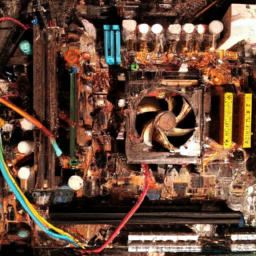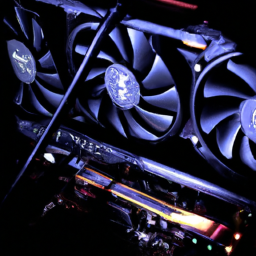Can Cryptocurrency Mining Damage My Hardware?
Have you ever wondered about the potential risks that come with diving into the world of cryptocurrency mining? As the popularity of digital currencies continues to rise, more and more people are getting involved in mining to earn their share of this lucrative market. But amidst all the excitement, there is a lingering concern: can cryptocurrency mining actually damage your precious hardware?
In this article, we will explore this very question and shed some light on the potential risks involved in cryptocurrency mining. We will carefully examine the impact of mining on your hardware, discussing overheating issues, increased power consumption, and other potential pitfalls that miners may encounter. So, if you’re interested in the fascinating world of cryptocurrency mining and want to protect your hardware investment, read on to find out all you need to know about the topic. Yes, cryptocurrency mining can potentially damage your hardware if not properly managed. In this comprehensive article, we will explore the ins and outs of cryptocurrency mining, the hardware necessary for it, the strain it places on your hardware, potential damages that can occur, signs of damage to watch out for, ways to prevent damage, how to repair damaged hardware, alternatives to mining, and the economic trade-off of mining. By understanding these aspects, you can make informed decisions about cryptocurrency mining and ensure the longevity of your hardware.
Understanding Cryptocurrency Mining
Cryptocurrency mining is the process of verifying and adding transactions to the blockchain network, the backbone of any cryptocurrency. It involves using specialized hardware to solve complex mathematical problems that secure the network. Through this process, miners can earn cryptocurrencies as a reward for their computational work.
How Cryptocurrency Mining Works
In order to understand the potential for hardware damage, it’s important to have a basic understanding of how cryptocurrency mining works. Miners use powerful computer hardware, including GPUs (Graphics Processing Units) and CPUs (Central Processing Units), to solve complex mathematical algorithms. As these algorithms are solved, transactions are validated and added to the blockchain. The first miner to solve the algorithm and validate the transactions is rewarded with cryptocurrency.
Significance of Cryptocurrency Mining
Cryptocurrency mining plays a vital role in maintaining the integrity and security of the blockchain network. Miners act as decentralized auditors, ensuring that transactions are valid and preventing double-spending. Additionally, mining provides an incentive for individuals to participate in the network, contributing their computational power to keep the blockchain secure.
Hardware Necessary for Cryptocurrency Mining
To engage in cryptocurrency mining, you will need a mining rig, which consists of several components working together to perform the necessary computations.
Components of a Mining Rig
A typical mining rig consists of a motherboard, a CPU, multiple GPUs, RAM, storage devices, power supplies, cooling systems, and an internet connection. Each component works in harmony to efficiently mine cryptocurrencies.
Top Hardware Options for Mining
When choosing hardware for mining, it’s crucial to consider factors such as computational power, energy efficiency, and cost-effectiveness. Popular options for mining include GPUs from companies like Nvidia and AMD, as they offer high hash rates and strong computational capabilities. ASIC (Application-Specific Integrated Circuit) miners are also widely used for cryptocurrencies that are not GPU-friendly, such as Bitcoin.
How to Choose the Right Hardware for Mining
Choosing the right hardware for mining depends on several factors, including the type of cryptocurrency you want to mine, your budget, and your energy costs. Researching the specific requirements for different cryptocurrencies can help you determine the most suitable hardware for your mining needs. Additionally, considering the availability and cost of the hardware is essential, as certain models may be in high demand or have inflated prices.
The Strain Cryptocurrency Mining Places on Hardware
Cryptocurrency mining is an intensive computational process that places a significant strain on hardware components. Understanding the computational demands and how mining taxes the GPU and CPU is crucial in mitigating potential damage.
Understanding the Computational Demands
Cryptocurrency mining requires constant and intense computational power to solve complex mathematical problems. This constant demand for processing power can push hardware components to their limits, causing increased wear and tear.
How Mining Taxes the GPU and CPU
The GPU and CPU are the two primary workhorses in cryptocurrency mining. The GPU is responsible for most of the computational work, while the CPU handles ancillary tasks. Both components are subject to high temperatures and stress during mining, which can shorten their lifespan and potentially lead to hardware failure.
Comparison of Mining Strain to Other Computing Tasks
Mining cryptocurrency places a much heavier strain on hardware compared to typical computing tasks. While general computer usage involves occasional spikes in processing power, mining requires a sustained high level of computational performance. This prolonged strain can accelerate the deterioration of hardware components.
Direct Damage from Cryptocurrency Mining
In addition to the strain placed on hardware, there are several direct damages that can occur as a result of cryptocurrency mining.
Wear and Tear Due to Constant Use
As mentioned earlier, cryptocurrency mining involves the continuous use of hardware components at their maximum capacity. This constant usage can contribute to accelerated wear and tear, potentially leading to premature hardware failure.
Overheating Risks and Effects
The intense computational workload of mining generates a significant amount of heat, placing hardware components at risk of overheating. Overheating can cause performance degradation, decreased lifespan of components, and in extreme cases, irreversible damage.
Potential for Electrical Issues
Mining rigs consume a substantial amount of electricity due to their constant operation. This increased power draw can put strain on electrical circuits, potentially causing issues such as tripped breakers or even electrical fires. It is essential to ensure that your electrical infrastructure can handle the increased load before engaging in mining activities.
Indirect Damage from Cryptocurrency Mining
Aside from the direct damage discussed, there are also indirect damages that can result from cryptocurrency mining.
Issues from Inadequate Cooling Systems
Efficient cooling systems are essential to maintaining optimal operating temperature levels for mining hardware. Inadequate cooling can lead to thermal throttling, decreased performance, and an increased risk of overheating. Investing in robust cooling solutions, such as high-quality fans or liquid cooling systems, can help mitigate these risks.
Damage Due to Poor Maintenance
Regular maintenance is crucial to the longevity of mining hardware. Dust accumulation, improperly applied thermal paste, and neglecting to clean or replace fans can all contribute to decreased performance and potential hardware failure. Implementing a maintenance schedule and following manufacturer recommendations can help minimize these risks.
Risks from Subpar Power Supply
A stable and reliable power supply is essential for mining rigs. Cheap or low-quality power supplies may struggle to deliver consistent power, leading to voltage fluctuations or inadequate power delivery. These issues can result in unstable mining operations and potential damage to hardware components.
Signs of Cryptocurrency Mining Damage
It’s important to be aware of the signs of damage caused by cryptocurrency mining to address potential issues promptly.
Performance Issues or Hardware Failure
One of the most apparent signs of mining damage is a decrease in performance or complete hardware failure. mining-related strain can manifest as system crashes, graphic artifacts, slow processing speeds, or inability to boot up. If you experience any of these issues, it’s crucial to investigate the possibility of mining damage.
Visible Damage or Unusual Noises
Inspecting your mining rig for visible damage, such as burn marks, swollen capacitors, or loose connections, is essential. Unusual noises, such as grinding or clicking sounds coming from fans or hard drives, can also indicate potential damage.
Increased Electricity Bills
Mining rigs consume a significant amount of electricity, and a sudden increase in your electricity bill can be a sign of mining-related damage. If you notice a substantial spike in your energy costs without a reasonable explanation, it may be worth investigating potential issues with your mining hardware.
Preventing Damage from Cryptocurrency Mining
While mining can put strain on your hardware, taking preventive measures can help minimize the risk of damage.
Importance of Regular Maintenance
Regular maintenance is crucial to keeping your mining hardware in optimal condition. This includes cleaning dust from fans and components, replacing thermal paste, and monitoring temperature levels. Implementing a maintenance routine can significantly extend the lifespan of your hardware.
Choosing Hardware Designed for Long-lasting Performance
When selecting mining hardware, it is essential to choose components known for their durability and longevity. Researching and investing in high-quality GPUs, CPUs, and power supplies can help minimize the risk of damage and ensure long-lasting performance.
Utilizing Proper Cooling Methods
Efficient cooling is key to preventing overheating and reducing strain on mining hardware. Utilizing cooling solutions such as fans, heatsinks, or liquid cooling can help maintain lower temperatures, decrease the risk of hardware failure, and ensure optimal performance.
Repairing Hardware Damaged by Cryptocurrency Mining
In the unfortunate event that your hardware is damaged by cryptocurrency mining, understanding when to repair versus replace, common repairs necessary after mining, and finding a qualified hardware repair professional are essential.
When to Repair vs Replace Hardware
The decision to repair or replace mining hardware depends on the extent and cost-effectiveness of the repair. Minor issues, such as replacing a fan or cleaning components, can typically be addressed with repairs. However, if the damage is extensive or the cost of repair exceeds the value of the hardware, replacement may be the more viable option.
Common Hardware Repairs Necessary After Mining
Some common hardware repairs that may be necessary after mining include replacing fans, addressing overheating issues, repairing damaged circuitry, or replacing worn-out components. these repairs require expertise and should be carried out by professionals experienced in mining hardware.
Finding a Qualified Hardware Repair Professional
When seeking repairs for mining hardware, it’s essential to find a qualified professional with experience in repairing and diagnosing issues specific to mining rigs. Look for reputable repair services that specialize in mining hardware or seek recommendations from other miners in the community.
Alternatives to Mining for Earning Cryptocurrency
If the potential risks and damages associated with mining concern you, there are alternative methods for earning cryptocurrency.
Buying Cryptocurrency Directly
One option is to simply purchase the cryptocurrency you wish to acquire. This involves buying it from reputable exchanges or platforms using traditional currency. While this method does not involve mining, it allows you to acquire cryptocurrencies without the risks associated with hardware damage.
Crypto Staking
Crypto staking involves owning and holding a certain amount of a particular cryptocurrency in a designated wallet to support the network’s operations. In return for holding and validating transactions, participants receive additional cryptocurrency as a reward. Staking can be a viable alternative for those looking to earn cryptocurrency without the need for specialized mining hardware.
Using Cloud Mining Services
Cloud mining services allow individuals to rent mining equipment remotely from a provider. This eliminates the need to invest in expensive hardware and take on the associated risks. However, it’s important to thoroughly research and choose reputable cloud mining service providers to mitigate potential scams or fraud.
The Economic Trade-off of Cryptocurrency Mining
Lastly, it’s crucial to analyze the potential profits from mining, weigh the costs of hardware replacement, and understand the decreasing profitability of mining.
Analyzing Potential Profits from Mining
The profitability of mining depends on various factors, including the cryptocurrency you mine, electricity costs, mining difficulty, and the price of the cryptocurrency. It is essential to calculate potential profits and consider the return on investment before committing to mining as a means of earning cryptocurrency.
Weighing the Costs of Hardware Replacement
Hardware replacement costs are a significant consideration when engaging in cryptocurrency mining. Due to the strain placed on hardware, certain components may need to be replaced periodically to maintain performance and mitigate the risk of failure. Factoring in these costs when assessing the profitability of mining is crucial.
Understanding the Decreasing Profitability of Mining
As cryptocurrencies become more popular and widely adopted, mining difficulty tends to increase, resulting in lower profitability. Additionally, the cost of hardware and electricity can impact profitability. It’s important to stay up-to-date with market trends and continuously evaluate the profitability of mining to ensure it remains a viable option.
In conclusion, while cryptocurrency mining can be a lucrative endeavor, it is not without risks. The strain placed on mining hardware, both direct and indirect, can potentially lead to damage and decreased performance. By understanding the potential damages, signs to watch out for, preventative measures, repair options, and alternative methods for earning cryptocurrency, you can make informed decisions, minimize risk, and ensure the longevity of your hardware in the world of cryptocurrency mining.







